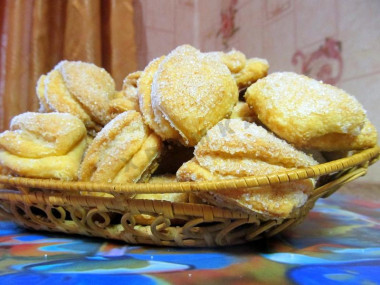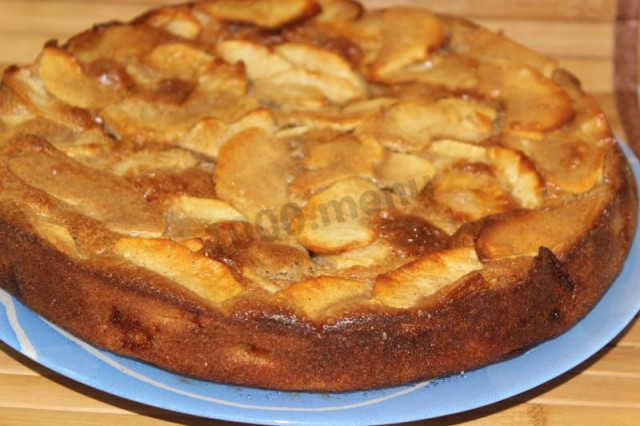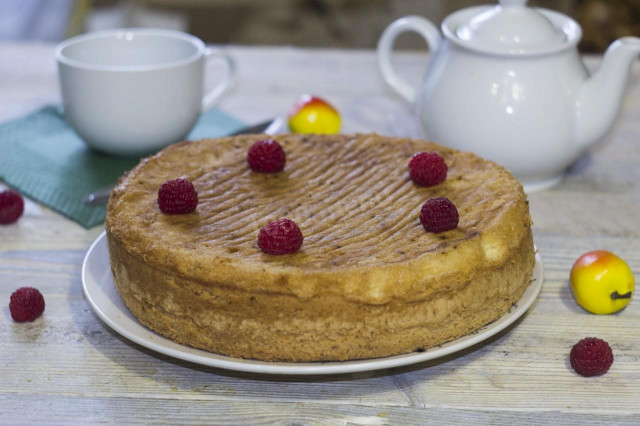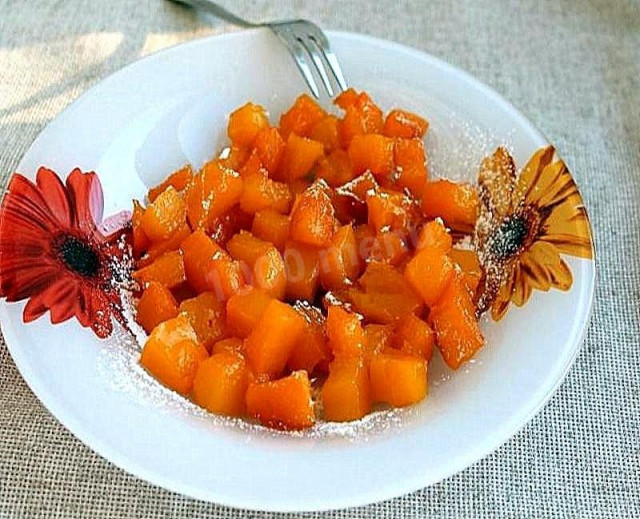Composition / ingredients
Step-by-step cooking
Step 1:
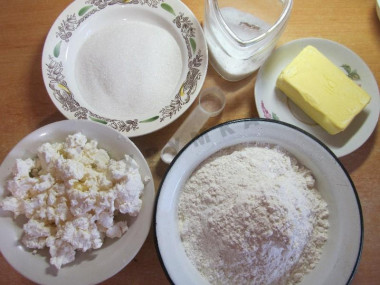
For the recipe, I specially weighed all the ingredients. I usually take 1 cup of cottage cheese, 2 cups of wheat flour and a pack of butter. A few hours before cooking, remove the butter from the refrigerator so that it has time to soften at room temperature.
Step 2:
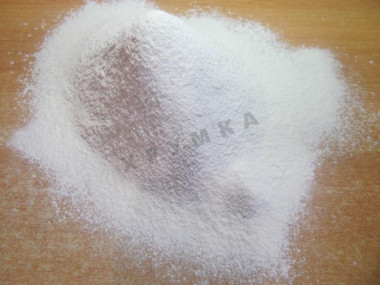
It is important to sift the flour to saturate it with oxygen. Then the baking will turn out to be airy and will rise well when baking. Note that you may need more or less flour. Everything will depend on its quality and grade. Therefore, just in case, sift it a little more than indicated in the recipe.
Step 3:
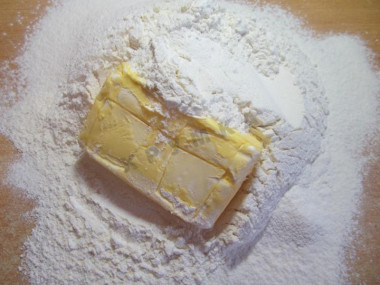
Put the soft butter in the flour slide. You can replace it with margarine. It will turn out delicious in both cases. But with butter, baking will be more useful.
Step 4:

Chop the butter with a knife, combining it with flour. The dough can be kneaded in a food processor. It will be faster and easier. In this case, cut the butter into small cubes, put it in the bowl of a combine, add flour and grind using a technique.
Step 5:

You should get a very fine homogeneous crumb.
Step 6:

Now add the cottage cheese. Which cottage cheese is best suited? You can take a product with any percentage of fat content. From a more fatty product (from 9% to 23% fat content), pastries will turn out tastier, but more caloric than from a low-fat one. Take not lumpy, but pressed cottage cheese. It is more homogeneous and mixes better with the rest of the ingredients.
Step 7:
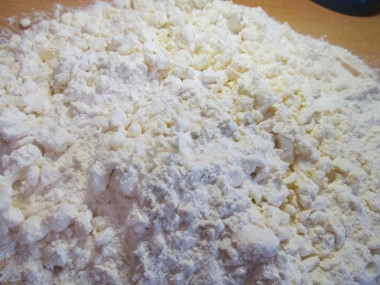
Continue to chop the curd-flour mass with a knife, mixing the components until smooth. Add soda and a pinch of salt, but it's not necessary. Without them, cookies turn out no worse! If you are afraid of the taste of soda, replace it with baking powder (1 tsp).
Step 8:
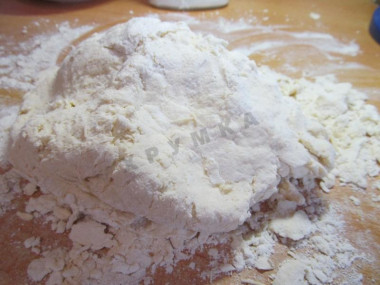
Knead the dough for about 5 minutes, collecting it into a ball. At first it will crumble. But in the process of kneading, it will become elastic, soft and obedient. The consistency of the dough turns out to be plastic, smooth and not very steep. If it continues to stick to your hands, add a little flour.
Step 9:

The resulting dough bun can be wrapped in plastic wrap and put in the refrigerator for 1 hour. After lying in the cold, it will become more elastic and will not crumble. But, if you do not have additional time, it is not necessary to do this. The dough rolls out no worse and without cooling. And you will significantly save cooking time. Divide the dough into two parts.
Step 10:
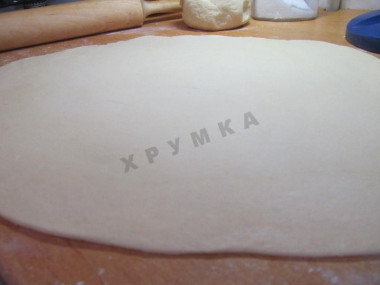
Sprinkle the work surface with flour so that the curd dough does not stick to it. Lay out the first part of the test. Roll it out into a thin layer 2 mm wide.
Step 11:
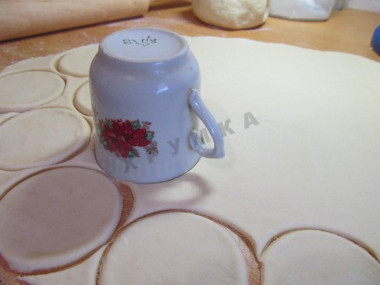
With a small glass, glass, cooking ring or mug, squeeze out circles with a diameter of 9-10 cm.
Step 12:
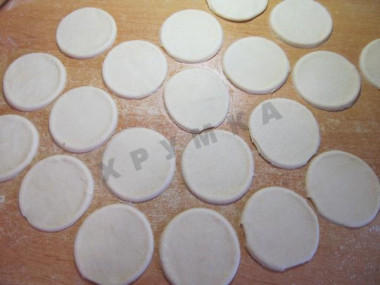
Collect the dough scraps and add them to the remaining half of the dough. Re-knead and set aside. We will roll out this dough a little later, but for now we will start forming cookies from circles.
Step 13:
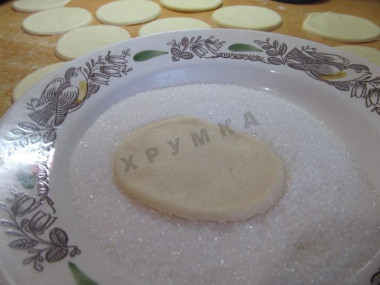
Pour granulated sugar into a plate. Ordinary white sugar can be replaced with brown sugar. Then the finished pastries will acquire a pleasant caramel aroma and taste. Take one circle of dough. Dip it with one side in sugar. To keep the sugar better on the surface, you can lightly beat the egg in a separate plate. First, lubricate the surface with a silicone brush with egg mixture, and then dip it in granulated sugar.
Step 14:
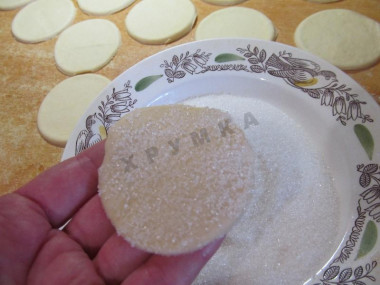
Turn the circle on the palm of your hand with the sugar side up.
Step 15:
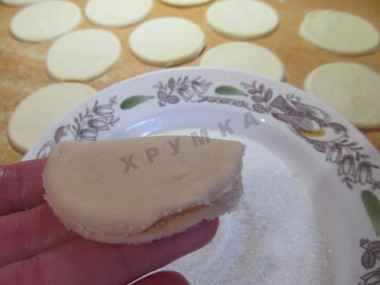
Fold the circle in half. The shape of the dumpling will turn out, and the sugar will be inside.
Step 16:
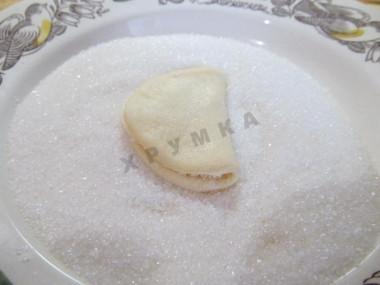
Dip in sugar again, but only one side.
Step 17:

Turn the blank over.
Step 18:
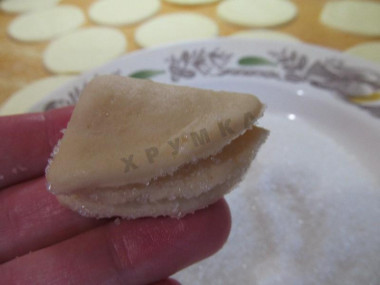
Fold in half again. So it turned out to be a triangular envelope.
Step 19:
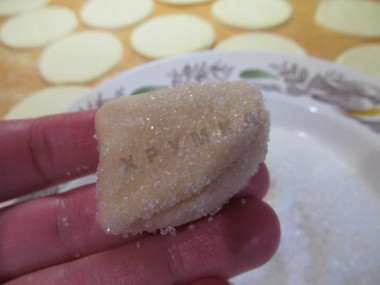
Dip one side in sugar for the last time. The curd triangle is ready.
Step 20:

Repeat the procedure with the remaining dough circles. Roll out the second layer of dough and do the same. So that our cookies do not stick during baking and do not burn, be sure to cover the baking sheet with baking paper. Or use a Teflon mat, if you have one in stock. Place the blanks on a baking sheet so that the sugar side is on top. Since they will grow up in the oven, leave some distance between them.
Step 21:

In advance (10-15 minutes before baking), turn on the oven to warm up to 180 degrees. Bake the cookies for about 15-20 minutes until browned. The ovens are all different and with their own characteristics, so the temperature and baking time may be different. Be guided by the color of the baking. When she gets a golden "tan", take it out.
Step 22:
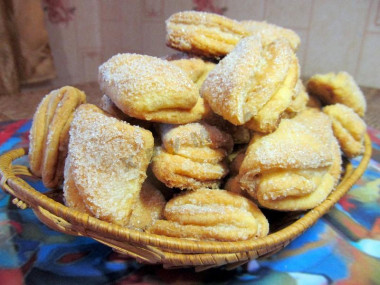
Cottage cheese triangles are ready! Remove the cookie sheet from the oven. Carefully transfer the pastries to a platter. Hot cookies are soft and there may be a false impression that they are not baked, but when they cool down, a golden sugar crust will appear on top, and the cookies will remain soft inside. The finished delicacy should cool completely. So that the waiting time does not drag on too long, brew your favorite fragrant tea. Have a nice tea party!
Cookies turn out to be very tasty, crispy, crumbly, puff! You can experiment with the recipe. For example, take sour jam instead of sugar. Do not apply it a lot, otherwise the cookies will not rise well in the oven. You can wrap a seedless cherry in the dough. fold the circle not with a triangle, but with a "dumpling" or a tube. Before serving, the finished pastries can be sprinkled with powdered sugar through a fine strainer. Try to cook it - you will like it!
Be prepared for the fact that flour may need a little more or, conversely, less than indicated in the recipe. You need to focus on how the dough should turn out (dense, soft, liquid, etc.). There is a lot of useful information about why flour, even of the same variety, can have completely different properties, read this article
Keep in mind that everyone's ovens are different. The temperature and cooking time may differ from those specified in the recipe. To make any baked dish turn out successfully, use useful information in the article about ovens here
Caloric content of the products possible in the composition of the dish
- Cottage cheese of 40% fat content - 466 kcal/100g
- Cottage cheese of 20% fat content - 233 kcal/100g
- Cottage cheese of 18% fat content - 226 kcal/100g
- Cottage cheese of 10% fat content - 156 kcal/100g
- Low-fat cottage cheese - 75 kcal/100g
- Cottage cheese with sour cream - 260 kcal/100g
- Fruit cottage cheese - 147 kcal/100g
- Soft dietary cottage cheese - 170 kcal/100g
- Cottage cheese "vitalinia" - 64 kcal/100g
- Cottage cheese "morning" ( "danone") without sugar - 91 kcal/100g
- Cottage cheese - 156 kcal/100g
- Whole durum wheat flour fortified - 333 kcal/100g
- Whole durum wheat flour, universal - 364 kcal/100g
- Flour krupchatka - 348 kcal/100g
- Flour - 325 kcal/100g
- Granulated sugar - 398 kcal/100g
- Sugar - 398 kcal/100g
- Butter 82% - 734 kcal/100g
- Amateur unsalted butter - 709 kcal/100g
- Unsalted peasant butter - 661 kcal/100g
- Peasant salted butter - 652 kcal/100g
- Melted butter - 869 kcal/100g
- Vegetable oil - 873 kcal/100g
- Salt - 0 kcal/100g
- Baking soda - 0 kcal/100g


